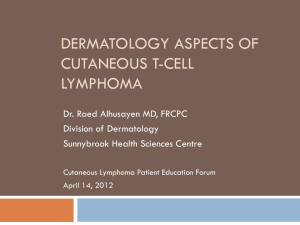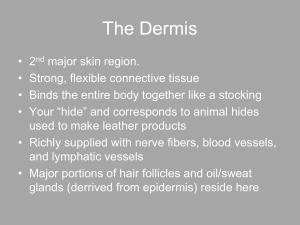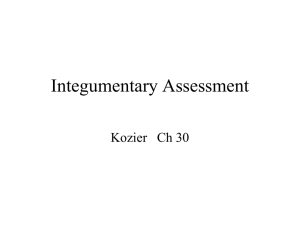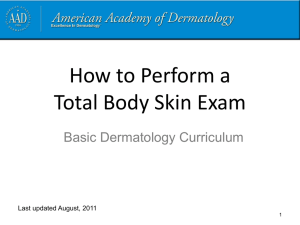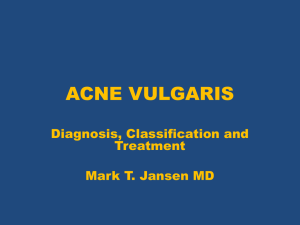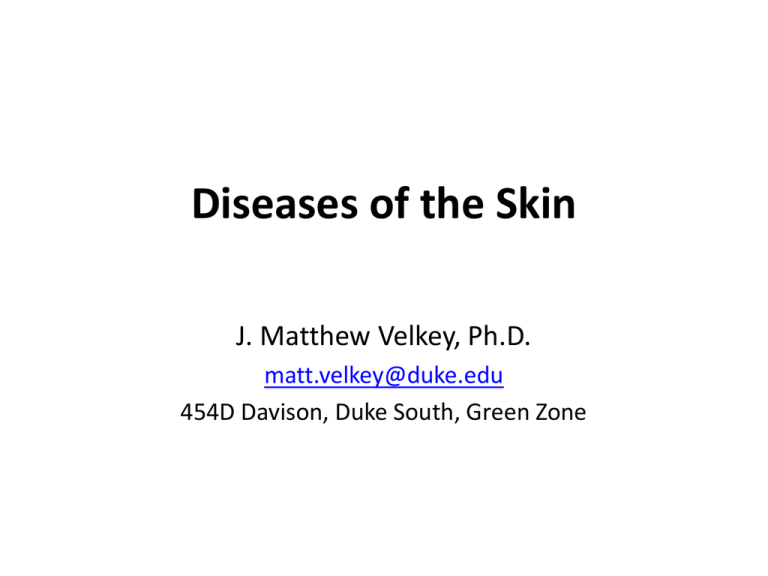
Diseases of the Skin
J. Matthew Velkey, Ph.D.
matt.velkey@duke.edu
454D Davison, Duke South, Green Zone
Lecture Outline
•
Cutaneous wound healing
•
– Healing by first intention
– Healing by second intention
– Wound strength changes
Pathologic aspects of repair
•
Acute Inflammatory Dermatoses
– Urticaria
– Acute Eczematous Dermatitis
– Erythema Multiforme
•
– Bacterial skin infections
– Fungal skin infections
– Viral skin infections
•
•
Blistering (Bullous) Skin Disorders
– Pemphigus
– Bullous Pemphigoid
– Dermatitis Herpetiformis
•
Benign & premalignant neoplasia
– Seborrheic keratosis
– Actinic keratosis
•
Malignant epidermal neoplasia
– Squamous cell carcinoma
– Basal cell carcinoma
Chronic Inflammatory Dermatoses
– Psoriasis
– Lichen Planus
– Lichen Simplex Chronicus
Infectious Dermatoses
•
Melanocytic neoplasia
– Melanocytic nevi
– Melanoma
Wound Healing
• A complex but orderly process involving many of the
chemical mediators previously discussed, along with
many other growth factors and cell-matrix interactions.
• Occurs in the following steps:
1.
2.
3.
4.
5.
6.
Injury induces acute inflammation
Parenchymal cells regenerate
Both parenchymal and connective tissue cells migrate and
proliferate
Extracellular matrix is produced
Parenchyma and connective tissue matrix remodel
Increase in wound strength due to collagen deposition
Wound Healing Time Course
Granulation Tissue
• Hallmark of healing
• Term comes from soft, pink, granular
appearance when viewed from the surface of
a wound
• Histology: Proliferation of small blood vessels
and fibroblasts; tissue often edematous
Granulation Tissue
Granulation Tissue
Healing by 1st intention vs. 2nd intention
By 1st intention:
• “clean” incision
• limited scarring or
wound contraction
By 2nd intention:
• ulcers or
lacerations
• often scarring and
wound contraction
Ulcers: an example of healing by 2nd intention
Resolution of Inflammation:
“Regeneration” vs. “Healing”
Myocardial Infarct: healing (aka “remote”)
Healing (remote) infarct
Variables affecting repair
•
•
•
•
•
•
•
Infection –prolongs inflammation, increases degree of tissue injury
Nutrition –protein or vitamin deficiency can impair synthesis of new proteins
Anti-inflammatory drugs –can impede fibrosis necessary for repair
Mechanical variables –tension, pressure, or the presence of foreign bodies can affect repair
Vascular disease –limits nutrient and oxygen supply required for repairing tissues
Tissue type –only tissues capable of renewing will regenerate, otherwise healing is by fibrosis
Degree of exudate removal –adequate removal of exudate allows RESOLUTION of the injury
(general restoration of the normal tissue architecture); inadequate removal results in ORGANIZATION
(abnormal, dysfunctional tissue architecture)
•
Regulation of cell proliferation –abnormal proliferation of connective tissue may inhibit reepithelialization and/or raised scars (keloids)
Acute Inflammatory Dermatoses:
Urticaria, aka “hives”
•
•
Very common condition, mediated by localized mast cell degranulation resulting in
dermal capillary hyperpermeability
Pathogenesis:
– Usually a hypersensitivity reaction (type I) mediated by IgE antibodies bound to mast cells
– Upon exposure to antigen (allergen), bound IgE antibodies induce signal cascades that lead to
degranulation of mast cells and release of histamine and other pro-inflammatory molecules
that cause invasion of inflammatory cells from blood vessels into connective tissue
– Results in wheals: erythematous (red), edematous (swollen), and pruritic (itchy) plaques
•
Clinical features:
– Most common in 20-40 year olds, but can occur at any age
– Can vary from small pruritic papules to large edematous plaques
– Can be localized to areas specifically exposed to allergen or more widespread to sites exposed
to pressure (waist, neck, wrists, ankles, ears)
– Lesions usually develop and fade within hours of exposure to allergen, but can persist for days
or even months (in instances where reaction causes more significant vascular damage)
Urticaria
Perivascular
inflammation
Wheals
Acute Inflammatory Dermatoses:
Acute Eczematous Dermatitis
•
•
Eczema: skin condition characterized by red, papulovesicular, oozing and crusted lesions
that with time develop into raised, scaling plaques.
Pathogenesis:
– Essentially a delayed-type, T-cell mediated (i.e. type IV) hypersensitivity reaction: Upon
initial exposure to antigen, Langerhans cells process antigen and present it to T cells in lymph
nodes to generate CD4+ T-cells sensitized to that antigen
– Upon re-exposure to antigen, sensitized CD4 T-cells migrate to skin site and release proinflammatory factors leading to mast cell degranulation and local tissue damage
•
Clinical features:
– Pruritic, edematous, oozing plaques, often w/ vesicles and bullae
– Microscopically, fluid accumulation seen within the epidermis (spongiosis) along with
perivascular inflammation, and sometimes local eosinophilia
– With persistent exposure and irritation, plaques can become raised and scaly
• Sub-types:
–
–
–
–
–
Allergic contact: most common type, reaction to topical antigens (e.g. poison ivy)
Atopic: unknown cause, but occurs more in those with asthma so auto-immune
Drug-related: reaction to systemically administered drugs (e.g. penicillin)
Photoeczema: reaction to UV light exposure
Primary irritant: non-immunologic reaction to chemical irritants
Acute Eczematous Dermatitis
Contact dermatitis (reaction to necklace)
Epidermal spongiosus
Acute Inflammatory Dermatoses:
Erythema Multiforme
• Hypersensitivity response to
certain drugs and/or infections
– Drugs: sulfonamides, penicillin,
salicylates, antimalarials
– Infections: herpes simplex virus,
mycoplasma, fungi
• Pathogenesis:
– T-cell mediated reaction similar to
eczema
• Clinical features:
– “target lesions” blister surrounded by
red rim
– Microscopically shows “margination” of
lymphocytes at dermal-epidermal
boundary and basal epidermal necrosis.
– Broad range of serverity from minor
(e.g. herpesvirus reaction) to severe
(systemic drug reaction)
– If severe can lead to loss of significant
areas of epidermis
Chronic Inflammatory Dermatoses:
•
•
Psoriasis
Rather common chronic inflammatory skin condition affecting 1-2% of people in U.S.
Pathogenesis:
–
–
–
•
Immunologic, but unknown whether antigens are self or environmental
CD4+ and CD8+ T-cell mediated; secrete factors that lead to keratinocyte hyperproliferation
Lesions often induced by local trauma and inflammatory response that then goes awry
Clinical features:
–
–
–
Most often affects elbows, knees, scalp, lumbosacral areas, intergluteal cleft and glans penis
Well-demarcated pink-colored plaques covered by sliver-white scale
Microscopically shows epidermal thickening (acanthosis), elongation of rete pegs, loss of stratum
granulosum, and parakeratosis
Chronic Inflammatory Dermatoses:
Lichen Planus
Pruritic, purple, polygonal, planar papules and plaques; self-limited and resolving usually in 1-2 yrs
• Pathogenesis:
–
•
Altered antigens (either due to drug treatment or viral infection) in basal cell layer causes CD8+ T-cells to
elicit a cytotoxic immune response
Clinical features:
–
–
–
Pruritic, purple, flat-topped papules that may coalesce into larger plaques highlighted by white, netlike
markings (Wickham striae)
Lesions may show hyperpigmentation due to melanin “leakage” into dermal layer
Microscopically shows intense accumulation of inflammatory cells at the basal cell layer (interface
dermatitis), basal squamatization, and hypergranulosis
Chronic Inflammatory Dermatoses:
Lichen Simplex Chronicus
Roughening of skin reminiscent of lichen on a tree
• Pathogenesis:
–
•
Probably due to repeated trauma (e.g. repeated itching) inducing
epithelial hyperplasia and dermal scarring
Clinical features:
–
–
Raised lesions with variable pigmentation and/or erythema
Microscopically shows stratum spinosum hyperplasia (acanthosis),
hyperkeratosis, and hypergranulosis.
Infectious Dermatoses:
Bacterial Skin Infections
Can range from superficial infections (impetigo) to deeper dermal abscesses
• Superficial infection (impetigo)
–
–
–
–
•
Primarily seen in children
Usually caused by Staphylococcus and Streptococcus species
Generally begins with a single macule that then evolves into a larger, crusty lesion
Most often affects extremities, nose, and mouth
Dermal abscess
–
–
Usually caused by anaerobic species such as Pseudomonas aeruginosa
Often associated with puncture or surgical wounds
Infectious Dermatoses:
Fungal Skin Infections
a.k.a “tinneas”
• Superficial infections
–
–
•
Usually caused by Candida (yeast) species
Can mimic psoriasis, so any biopsy should include fungal stain
Deeper infections
–
–
–
Usually caused by filamentous species such as Aspergillus
Primarily seen in immuno-compromised hosts (post-transplant, elderly, HIV infection)
More tissue damage so generally erythematous and nodular
Infectious Dermatoses:
Verrucae (warts)
Common lesions in children and adolescents, usually resolving in 6mo – 2yrs
• Pathogenesis:
– Most often cause by infection with some type of Human Papilloma Virus (HPV), which
subverts cell cycle control and elicits epithelial hyperplasia
– Some types of HPV (e.g. types 6, 16, and 18) are oncogenic; however, most warts are caused
by non-oncogenic types (e.g. types 1, 2, 3, 4, 7, 8, 10, and 11)
•
Clinical features:
– Generally characterized by undulant epidermal hyperplasia. Microscopically features
cytoplasmic vacuolization (koilocytosis) in virus-infected cells in superficial epidermal layers.
Infected cells may also show prominent keratohyaline granules and eosinophilic intracellular
inclusions.
– Generally classified into various types based on morphology and location:
• Verrruca vulgaris: “common” wart, can occur anywhere, but usually on dorsum of hand,
assoc. with HPV-2 and HPV-7
• Verruca plana: “flat” wart; flat, smooth macules, assoc. with HPV-3, -8, -10
• Verruca plataris/palmaris: occur on soles and/or palms, 1-2 cm in diameter, assoc. with
HPV-1, -2, and -4
• Genital warts: occur on genitalia, perineum, and perianal regions, assoc. with HPV-6, -11
Infectious Dermatoses:
Verrucae (warts)
common warts
koilocytosis
plantar warts
Blistering Disorders:
Pemphigus
Loss of integrity within the epidermis
• Pathogenesis:
– Type II hypersensitivity reaction in which antibodies are produced against desmosomal
proteins leading to auto-immune disruption of their function
•
Clinical features:
– Generally characterized by loss of adhesion between cells within the epidermis (acantholysis)
and variable dermal inflammation. The acantholysis can be more superficial (subcorneal) or
deeper (suprabasal) depending on the type of pemphigus:
• Pemphigus vulgaris: more common and, unfortunately, more severe type; involves
mucosa and skin particularly on scalp, face, axilla, groin, trunk, and/or any pressure
point; acantholysis is typically suprabasal and therefore more severe.
• Pemphigus foliaceous: rare but more benign form, acantholysis typically more
subcorneal
Pemphigus vulgaris
Pemphigus foliaceous
Blistering Disorders:
Bullous Pemphigoid
Pathogenesis:
– Type II hypersensitivity reaction in which IgG
antibodies are produced against hemidesmosomal
proteins leading to auto-immune disruption of their
function
– Antibody-antigen complexes also fix complement in
region leading to local tissue destruction
Clinical features:
– Entire epidermis separates from the dermis leading
to the formation of tense, fluid-filled bullae that are
more resistant to rupture compared to blisters seen
in pemphigus
– Generally affects elderly patients
– Sites of occurrence include inner thighs, flexor
surfaces of forearms, axilla, groin and lower
abdomen.
hemidesmosome antibodies
Blistering Disorders:
Dermatitis herpetiformis
Rare disorder characterized by urticaria
and grouped vesicles
Pathogenesis:
– Associated with celiac disease: anti-gluten IgA
antibodies cross react with epidermal
anchoring fibril proteins leading to subepidermal blistering
Clinical features:
– Extremely pruritic urticarial plaques
– Microscopically shows fibrin and neutrophil
accumulation at dermal papillae tips and
separation of the epidermis from the dermis
– Lesions are typically bilateral, symmetric, and
grouped involving extensor surfaces, elbows,
knees, upper back, and buttocks
– Predominantly seen in males, 20-30 years old
anchoring fibril antibodies
Benign & Premalignant Neoplasia:
Seborrheic Keratosis
Common epidermal tumors seen in
middle age and elderly.
Pathogenesis:
– Most often associated w/ activating mutation
in FGFR-3 leading to epidermal hyperplasia
Clinical features:
– Round, flat, coin-like plaques millimeters to
centimeters in diameter
– Often tan to dark brown with velvety or
granular surface
– Microscopically consist of sheets of small
cells with variable basal hyperpigmentation
and hyperkeratosis at the surface leading to
formation of keratin-filled cysts
Premalignant Neoplasia:
Actinic Keratosis
Premalignant lesion associated with sun exposure (actinic = “sun-related”)
• Pathogenesis:
–
•
Often associated with mutation in p53, leading to defective apoptosis and hyperproliferation
Clinical features:
–
–
–
–
Lesions are generally <1cm in diameter, tan-brown, red, or skin-colored with rough sandpaper-like
consistency
Microscopically shows cytologic atypia and basal cell hyperplasia and parakeratosis; dermis may show
thickened, blue-gray elastic fibers (* in fig. A below)
More often found on sun-exposed areas (face, shoulders, back, arms)
Usually excised surgically or with local cryotherapy (freezing)
Malignant Neoplasia:
Squamous Cell Carcinoma
Common tumor arising on sun-exposed
sites in older people.
Pathogenesis:
– UV light exposure with subsequent
unrepaired DNA damage leads to loss of cell
cycle control and hyperproliferation
– Often associated with mutations in p53 and
RAS oncogenes
– Increased risk with UV B (tanning booth)
exposure, HPV exposure, other carcinogens
Clinical features:
– Red, scaling paques, often arising from actinic
keratoses; more advanced lesions ulcerate
– Microscopically consist of atypia throughout
all layers with metastasis into dermis
– Often discovered when small and resectable;
<5% metastasize (usually to nearby lymph
nodes as shown in fig. B)
Malignant Neoplasia:
Basal Cell Carcinoma
Most common cancer; also strongly correlated with sun exposure; slow-growing and rarely metastatic
• Pathogenesis:
–
•
Often associated with mutations in Sonic Hedgehog-Patched pathway and/or mutations in p53, leading to
aberrant growth factor response, defective apoptosis, and hyperproliferation.
Clinical features:
–
–
–
Lesions are generally pearlescent papules with prominent, dilated blood vessels and sometimes with
hyperpigmentation. Advanced lesions may ulcerate.
Microscopically appear as multifocal or multinodular growth of basal cell layer into dermis with
hyperchromatic, palisading nuclei
Usually excised surgically with little complication
Melanocytic Neoplasia:
Common Melanocytic Nevi
Pathogenesis:
–
Often associated with mutations RAS or downstream targets such as BRAF, leading to hyperproliferation of
melanocytes and growth into underlying dermis; can progress to melanoma.
Clinical features:
–
–
–
Lesions are <5mm, tan-brown, uniformly pigmented elevated papules with well-defined, rounded borders
Microscopically appear as “nests” of melanocytes in various stages of maturation: peripheral cells are less
mature, larger and more pigmented; deeper cells are smaller, more mature, and less pigmented
Usually excised surgically with little complication
Dysplastic Melanocytic Nevi
May occur sporadically or in a familial form
Pathogenesis:
– Also associated with mutations RAS or downstream targets such as BRAF, leading to hyperproliferation of
melanocytes and growth into underlying dermis
– Important to note that MOST melanomas arise de novo rather than from dysplastic nevi. Nonetheless they are
still a good indicator of overall risk (those with dysplastic nevi are at higher risk)
Clinical features:
– Usually >5mm and may occur as hundreds of lesions. Flat, raised macules with pebbly surface, irregular
pigmentation, and irregular borders. Found in sun-exposed AND non-exposed areas.
– Microscopically appear as “nests” of melanocytes with a high degree of atypia and a tendency to coalesce with
adjacent nests; single nevus cells replace the normal basal cell layer of the epidermis and proliferate, producing
so-called lentiginous hyperplasia
Melanoma
Less common than basal cell or squamous cell carcinoma, but much more deadly
• Pathogenesis:
– Associated with exposure to sunlight and loss of cell cycle control usually by loss of function of
p16 or PTEN or activating mutation in NRAS or BRAF. Interestingly, p53 usually NOT mutated.
– Initially radial or horizontal growth of melanocytes without metastasis before progressing to
more aggressive, downward vertical growth into dermis
– Probability of metastasis is correlated with depth of vertical invasion
– Metastasis is both lymphatic and hematogenous, so can easily spread to liver, lungs, brain,
etc.
•
Clinical features:
– Lesions typically arise in skin, but can also occur in oral or anogenital mucosae, esophagus,
meninges, or eye
– Microscopically shows severe atypia with large nuclei and eosinophilic nucleoli; malignant
cells may grow as nests within the epidermis in the “radial” phase or as expansile nodules
within the dermis in the “vertical” phase
– Lesions may be pruritic, but often asymptomatic; main signs of concern are:
A.
B.
C.
D.
E.
Asymmetry – uneven appearance and texture
Border – irregular borders
Color – uneven color (black, brown, red, dark blue, or even gray)
Diameter – greater than 6mm in size
Evolution – change in size, shape and/or color of a lesion with time –MOST IMPORTANT SIGN
radial phase
vertical phase
Melanoma
severe atypia
asymmetry, irregularity
WEAR
SUNSCREEN!!!!


